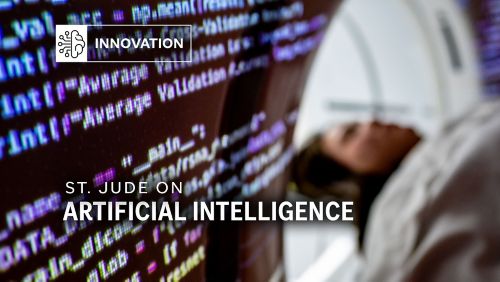St. Jude Family of Websites
Explore our cutting edge research, world-class patient care, career opportunities and more.
St. Jude Children's Research Hospital Home

- Fundraising
St. Jude Family of Websites
Explore our cutting edge research, world-class patient care, career opportunities and more.
St. Jude Children's Research Hospital Home

- Fundraising
Technology tidalwave: How artificial intelligence is shaping the future of radiology

Because radiology is already cemented in the digital space, AI is a natural complement and a valuable tool to improve the quality of scans, diagnostics and processes for both physicians and patients.
Technology can transform how knowledge is gathered, processed and applied. It can launch a new field seemingly overnight, as the invention of early X-ray machines did for radiology in 1895. Computed tomography (CT), positron emission tomography (PET) and magnetic resonance imaging (MRI) propelled the field forward with new capabilities throughout the 1960s and 1970s, and advancements are still coming. Keeping pace with the changing tides as new technologies become available is how field leaders stay at the cutting edge of discovery.
Artificial intelligence (AI), the practice of instructing computers to use logic and reasoning to complete tasks that humans typically do, is the next technological wave to reach the field of radiology. Andrew Smith, MD, PhD, Department of Radiology chair, is eager to bring these innovations to St. Jude. Currently, researchers are exploring novel AI tools. Indeed, radiology is where 75% of all Food and Drug Administration–approved AI algorithms are being applied.
“We’re interested in how we can use AI to do our jobs better and ultimately support our mission,” says Paul Yi, MD, Department of Radiology, Intelligent Imaging Informatics (I3) director. “AI helps us analyze massive amounts of data — more than a human might be able to do — all at once. It identifies patterns that might not be obvious to the human eye, and from there, it can make predictions or guide decisions that can improve research tasks or patient outcomes.”
Where obstacle meets innovation
While AI may not hold all the answers, its abilities make it an essential tool for solving problems and improving existing techniques. “We’re identifying problems and forming teams to develop solutions,” says Smith. “AI is one of the tools we have available to do that.”
Radiology is already cemented in the digital space, making AI applications a natural fit to complement the work radiologists regularly perform. As an example, research from Smith, published in the American Journal of Roentgenology, demonstrated that radiologists who used AI assistance to detect pulmonary embolisms via contrast-enhanced CT scans performed significantly better than radiologists who did not. Investigators are using these algorithms to help interpret and analyze imaging data and extend that data’s utility. In a 2023 study published in Neuro-Oncology Advances led by Brent Orr, MD, PhD, Department of Pathology, in collaboration with Asim Bag, MBBS, MD, Department of Radiology, investigators found that machine learning models could accurately predict tumor methylation types from MRI data. This could greatly expand the number and types of tumors that could be modeled using radiogenomics — the intersection between radiology and genomics.
Maximizing ability by standardizing results
One of the major problems in all scientific fields is ensuring that researchers do things the same way. This kind of standardization removes the “human error” aspect from research results and has long been sought after to maximize the ability of research to arrive at valuable conclusions. AI applications may be one solution.
An important aspect of a radiologist’s work is generating reports based on their findings. These documents follow a largely narrative structure; however, according to Yi, aspects could be standardized.
“We’re trying to create a report for radiologists that follows a standardized template. We want to take advantage of tumor response criteria validated through long-term studies so that radiologists are all on the same page — machines can do this kind of standardization.” In fact, previous research from Smith, published in the Journal of Clinical Oncology, has shown how AI can markedly reduce errors and improve the standardization and efficiency of radiologists evaluating and reporting on advanced cancer response to therapy.
However, not all AI solutions work effectively in clinical practice. One example from Smith, published in 2024 in the American Journal of Roentgenology, shows that when assessing intracranial hemorrhage (brain bleed) in CT scans, AI didn’t improve radiologists’ diagnostic performance or report turnaround times. However, that doesn’t mean that the technology will never get there.
Having identified these real-world limitations, researchers are examining how to use emerging technologies like large language models to improve data analysis tools. Published in the American Journal of Roentgenology in 2024 by Yi and Smith, such work demonstrated that the OpenAI-developed GPT-4 model could outperform a radiology domain-specific natural language processing model when it came to classifying imaging findings from chest radiograph reports. The results show that with proper guidance, such models could play a role in radiology.
On the horizon: AI impact for patients
In addition to solving problems and standardizing results, AI has other benefits. The technology has improved the image quality for CT and MRI scans, accelerating how quickly such images can be produced. This acceleration, in turn, can reduce patients’ time undergoing the scans, allowing kids to spend more time just being kids and less time in examinations.
Zach Abramson, MD, and his 3D Lab team (part of the I3 group led by Yi) also use AI to measure tumors and render them in three-dimensional models. These models can then be projected into virtual reality headsets, a valuable tool for both preoperative planning and patient education.
“A lot of times, patients and their families consent to these treatments without really understanding what’s going on in their bodies. But, as the adage goes, a picture is worth a thousand words. So, when patients and their parents see in 3D what’s actually going on, it translates in a way words cannot,” says Yi.
AI only knows what it knows
While there are many benefits, with every new technology, there are growing pains. Much of an AI’s output depends on the data on which it is trained, which also means it depends on the people who train it. Research by Yi, published in the Journal of Imaging Informatics in Medicine in 2024, found that if a deep learning tool is only trained on data images pertaining to adult patients, it might not translate its programming correctly to pediatric patients. This could then impose safety risks. Yi also showed that while some AI tools intended for diagnostics perform well in aggregate, they perform worse for historically disadvantaged populations, including racial minorities. That research was published in Emergency Radiology in 2024.
The concerns about algorithmic bias extend beyond the patient population to the very machines for which the AI is built. “The bias could be weight-based, age-based, gender-based, race-based — even a bias toward a particular type of manufacturer of the imaging tool,” says Smith. “We have one vendor for our MRI machines at St. Jude. So, it might work well here, for those machines, but not elsewhere.”
Additionally, Smith and Yi both acknowledge that the AI models must keep up with the pace of innovation in scanning technology. “Imaging was different five years ago, and it’ll be different five years from now — maybe in subtle ways,” says Smith. “To radiologists, the differences might seem trivial, but AI is what we call ‘brittle’ and may fail just once because of tiny changes.”
The challenge for researchers, including Smith and Yi, is how to train a brittle system and make it malleable — capable of adapting to new variables.
AI–human collaboration
The growth of AI will likely continue to accelerate, especially in research and clinical care. “One of the most exciting things is this future AI–human collaboration, where an AI can use its humanlike-level expertise and make a physician better. We’re not trying to replace human judgment; we’re trying to enhance it,” says Yi.
Likewise, Smith shares Yi’s optimism and emphasizes the value this brings to the children seeking treatment at St. Jude, “There are things that we do in clinical trials that we cannot achieve in clinical practice yet, and these AI solutions can bridge the gap and allow us to give better care.”






